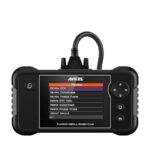Many users are curious about how their Fixd Bluetooth Obd2 scanner operates, especially when compared to simpler, cheaper devices on the market. As developers of FIXD, we want to provide insight into the complexities of modern vehicle diagnostics and explain why FIXD is designed the way it is to offer comprehensive and reliable car health information using a Bluetooth OBD2 adapter.
The Intricacies of OBD2 and CAN Bus Systems
At first glance, On-Board Diagnostics II (OBD2) and Controller Area Network (CAN bus) systems might seem straightforward. However, beneath the surface lies a sophisticated and intricate network. Those inexpensive OBD2 scanners, often priced around $15, typically offer limited functionality. They rely on small, on-device code databases, frequently compiled from public wikis, and often support only a single communication protocol and module within your vehicle. These basic scanners usually lack advanced features like error filtering or the ability to parse complex data frames, which are crucial for accurately diagnosing issues in a wider range of vehicles. They generally employ static, one-size-fits-all scripts that operate on a very restricted set of diagnostic addresses.
The real challenge emerges when you need to access modules beyond the engine control unit (ECU), such as airbags, tire pressure monitoring systems (TPMS), seatbelts, and transmission control units. These modules often communicate using different protocols, requiring the scanner to perform mid-stream protocol switching and negotiation – processes that are unique to each vehicle make, model, and year. Factors like specific baud rates further complicate the communication. Moving beyond basic Mode 3/7/9 hexadecimal to diagnostic trouble code (DTC) parsing quickly escalates the complexity.
Why FIXD Takes a Cloud-Based Approach for its Bluetooth OBD2 Scanner
Storing the vast and varied diagnostic logic for every vehicle directly within a mobile app is simply not feasible. The sheer volume of data, branching logic for different vehicle configurations, and manufacturer-specific protocols would necessitate a multi-gigabyte database. Furthermore, access to some diagnostic commands and instruction sequences is licensed and proprietary, requiring significant payments to automotive manufacturers.
To overcome these limitations, FIXD employs a dynamic, cloud-based approach. When you use your FIXD Bluetooth OBD2 scanner, the app first scans your car to assess its specific communication capabilities. It then downloads the latest, customized command list tailored to your particular vehicle from our servers. We have a dedicated team of engineering interns who focus on specific modules (for example, airbags in 2008-2012 Toyota models). This team develops and deploys test scripts, gathers diagnostic data, creates custom parsers, and releases regular updates to our command library.
Because these scripts are refreshed and downloaded every time you log in, your FIXD app receives updated diagnostic capabilities with each launch, even without a traditional app update. This dynamic system necessitates API calls, which in turn require network access and authentication tokens. While these scripts are cached locally on your device, an initial network connection is needed to retrieve them.
Addressing Login Requirements and Introducing Offline Mode for FIXD Bluetooth OBD2
We understand user concerns regarding the login requirement. FIXD began as a small startup, and our infrastructure was initially built around user accounts. We are currently undergoing a significant overhaul to streamline the signup process, including implementing auto-account generation, though this is a complex undertaking that will take time.
In response to user feedback, we’ve introduced an “offline mode” in version 7.1.1. If you have successfully logged into the FIXD app previously and cached the necessary data, you can now access the app even without an active internet connection. An “OFFLINE MODE” banner will indicate this reduced functionality. It’s important to note that live data features do not require network access once you are logged in and using the app within your vehicle. Network connectivity is primarily needed for initial authentication, login, and fetching the latest diagnostic scripts upon launch.
However, due to the reasons outlined above regarding the dynamic nature of vehicle diagnostics, comprehensive code scanning and reading will likely always require a network connection to ensure access to the most up-to-date and vehicle-specific diagnostic information. Currently, FIXD includes a network error prompt that automatically saves your scan data if your connection is interrupted. When connectivity is restored, tapping “Retry” will resubmit the raw data for parsing and allow the scan to continue seamlessly.
Understanding FIXD Premium and its Value Proposition with Bluetooth OBD2
FIXD Premium is an optional subscription service that provides enhanced features that incur ongoing costs for us. For example, the “confirmed fixes” feature is powered by a third-party service that compensates mechanics for their diagnostic data, and we pay them per API call. Similarly, the issue forecasting feature, which involves issue aggregation, machine learning analysis, and other complex backend processes, represents a significant ongoing investment. These value-added services would not be sustainable without a subscription model.
We are committed to improving our communication and clearly delineating which features are included in the free version of FIXD and which are part of Premium. We appreciate your feedback and encourage you to stay tuned for exciting new features planned for this year, both for free and premium FIXD users. We are continuously working to enhance the capabilities and user experience of your FIXD Bluetooth OBD2 device.
EDIT: Offline mode is now available in version 7.1.1! Remember to log in successfully at least once to enable the “Offline Mode” functionality. You can now also view basic codes from a scan in offline mode via the network error popup. This is just the initial release of offline mode, and we will continue to improve this feature in future updates.
